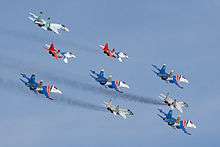Russians
Russians (Russian: русские) are an East Slavic ethnic group native to Eastern Europe,[43] who share a common Russian ancestry, culture, and history. Russian is the shared mother tongue of the ethnic Russians, and Orthodox Christianity is their historical religion. They are the largest Slavic nation, as well as the largest nation in Europe.
| Total population | |
|---|---|
134 million[1]
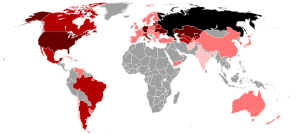 | |
| Regions with significant populations | |
| Diaspora | |
| 7,170,000 (2018) including Crimea[3] | |
| 3,644,529 (2016)[4] | |
| 3,500,000 (including Russian Jews and Russian Germans) 1,213,000 (excluding ethnic German repatriates)[5][6] | |
| 3,072,756 (2009) (including Russian Jews and Russian Germans)[7] | |
| 938,500 (2011) (including Russian Jews)[8] | |
| 785,084 (2009)[9] | |
| 750,000 (2016)[10] | |
| 622,445 (2016) (Russian ancestry, excluding Russian Germans)[11] | |
| 487,250 (2018)[12] | |
| 201,218 (2014)[13] | |
| 352,960 (2018)[14] | |
| 340,000[15] | |
| 327,802 (2020)[16] | |
| 300,000 (2018)[17] | |
| 150,000 (2012)[18] | |
| 129,797 (2017)[19] | |
| 120,459[20] | |
| 119,300 (2009)[21] | |
| 96,000[22] | |
| 85,534 (2018) (immigrants) 78,500 (descendants)[23] | |
| 67,055 (2006)[24] | |
| 50,000 (Russian ancestry)[25] | |
| 40,000 (2019)[26] | |
| 36,397 (2002) (Lipovans)[27] | |
| 35,759 (2016)[28] | |
| 35,000 (2010)[29] | |
| 30,098 (2016)[30][31] | |
| 26,453 (2014)[32] | |
| 21,518 (2016)[33] | |
| 20,187 (2016)[34] | |
| 15,609 (2000)[35] | |
| 15,595 (2002)[36] | |
| 14,660 (2002)[37] | |
| 13,635 (2002)[38] | |
| 7,686 (2019)[39] | |
| 5,979 (2013)[40] | |
| 4,952 (2001)[41] | |
| Languages | |
| Russian | |
| Religion | |
| Predominantly (Russian Orthodox Church) | |
| Related ethnic groups | |
| Other East Slavs (Belarusians, Ukrainians and Rusyns),[42] Eastern South Slavs (Bulgarians, Serbs, Macedonians, and Montenegrins) | |
The ethnic Russians were formed from East Slavic tribes and their cultural ancestry is based in Kievan Rus'. The Russian word for ethnic Russians is derived from the people of Rus' and the territory of Rus'. The Russians share many historical and cultural traits with other European peoples, and especially with other East Slavic ethnic groups, specifically Belarusians and Ukrainians.
Of the total 258 million speakers of Russian in the world,[44] roughly 134 million of them are ethnic Russians.[45] Majority of the Russians live throughout the Russian Federation, but notable minorities exist in other former Soviet states such as Belarus, Kazakhstan, Moldova, Ukraine and the Baltic states. A large Russian diaspora (sometimes including Russian-speaking non-Russians) has developed all over the world, with notable numbers in the United States, Germany, Brazil, and Canada. The number of ethnic Russians living outside the Russian Federation is estimated at roughly between 20 and 30 million people. Russian is an official language in Russia, Belarus, Kazakhstan, Kyrgyzstan, and Tajikistan, and is also spoken as a secondary language in many former Soviet states.
Ethnonym
Two Russian words are commonly translated into English as "Russians". One is "русские" (russkiye), which most often means "ethnic Russians" (the subject of this article). Another is "россияне" (rossiyane), which means "citizens of Russia". The former word refers to ethnic Russians, regardless of what country they live in or whether they hold Russian citizenship. Under certain circumstances, this term may or may not extend to denote members of other Russian-speaking ethnic groups from Russia, or from the former Soviet Union. The latter word refers to all people holding citizenship of Russia, regardless of their ethnicity, and does not include ethnic Russians living outside Russia. Translations into other languages often do not distinguish these two groups.[46]
The name of the Russians derives from the Rus' people (supposedly Varangians). According to the most prevalent theory, the name Rus', like the Finnish name for Sweden (Ruotsi), is derived from an Old Norse term for "the men who row" (rods-) as rowing was the main method of navigating the rivers of Eastern Europe. It could be associated to the Swedish coastal area of Roslagen (Rus-law) or Roden, as it was known in earlier times.[47][48] The name Rus' would have the same origin as the Finnish and Estonian names for Sweden: Ruotsi and Rootsi.[49] Although Russian history and culture is shaped also by Germanic people such as the Vikings, there are also theories that Rus' is of a non-Germanic origin. According to the historian Lydia Groth, Roslagen in IX—XII centuries was unsuitable for life, as it was under water at a depth of 6–7 meters. Furthermore, the name Roslagen was first documented only in 1493.[50][51] According to other theories the name Rus' is derived from Proto-Slavic *roud-s-ь ( from *rъd-/*roud-/*rуd- root), connected with red color (of hair)[52] or from Indo-Iranian (ruxs/roxs — «light-colored», «bright»).[53]
Until the 1917 revolution, Russian authorities never specifically called the people "Russians", referring to them instead as "Great Russians," a part of "Russians" (all the East Slavs).
History
Origin
The modern Russians formed from two groups of East Slavic tribes: Northern and Southern. These tribes included the Krivichs, Ilmen Slavs, Radimichs, Vyatiches and Severians. Genetic studies show that modern Russians do not differ significantly from Belarusians and Ukrainians. Some ethnographers, like Dmitry Konstantinovich Zelenin, affirm that Russians are more similar to Belarusians and to Ukrainians than southern Russians are to northern Russians. Russians in northern European Russia share moderate genetic similarities with Finnic peoples,[42][54] who lived in modern north-central European Russia and were partly assimilated by the Slavs as the Slavs migrated northeastwards. Such Finnic peoples included the Merya[55] and the Muromians.[54][56]
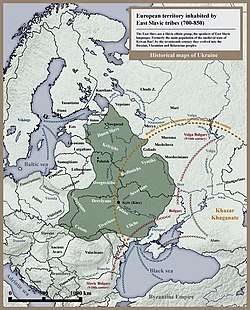
The territory of Russia has been inhabited since 2nd Millennium BCE by Indo-European, Ural-Altaic, and various other peoples; however, not much is known about them.[57] Slavic people are native to the western part of Russia.[58] Outside archaeological remains, little is known about the predecessors to Russians in general prior to 859 AD, when the Primary Chronicle starts its records.[59] By 600 AD, the Slavs are believed to have split linguistically into southern, western, and eastern branches.
The eastern branch settled between the Southern Bug and the Dnieper rivers in present-day Ukraine; from the 1st century AD through almost the turn of the millennium, they spread peacefully northward to the Baltic region, forming the Dregovich, Radimich and Vyatich Slavic tribes on the Baltic substratum. They developed some changed language features, such as vowel reduction. Later, both Belarusians and South Russians emerged from this ethnic linguistic ground or family.[60]
From the 6th century onward, another group of Slavs moved from Pomerania to the northeast of the Baltic Sea, where they encountered the Varangians of the Rus' Khaganate and established the important regional center of Novgorod. The same Slavic ethnic population also settled the present-day Tver Oblast and the region of Beloozero. With the Uralic substratum, they formed the tribes of the Krivichs and of the Ilmen Slavs.
Kievan Rus'
Kievan Rus' was a loose federation of states that existed from the late 9th to the mid-13th century. Modern Russians derive their name and cultural ancestry from Kievan Rus'.
Russian Empire
The Russian Empire was formed by Russians in modern-day Russia. It was given its name in 1721 and followed Russia’s victory over the Swedish Empire in what is known as the Great Northern War, in which Russia gained control of the Baltic.
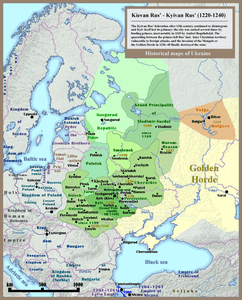 Principalities of Kievan Rus', 1220–1240. These principalities included Vladimir-Suzdal, Smolensk, Chernigov or Ryazan, annexed by the Duchy of Moscow in 1521
Principalities of Kievan Rus', 1220–1240. These principalities included Vladimir-Suzdal, Smolensk, Chernigov or Ryazan, annexed by the Duchy of Moscow in 1521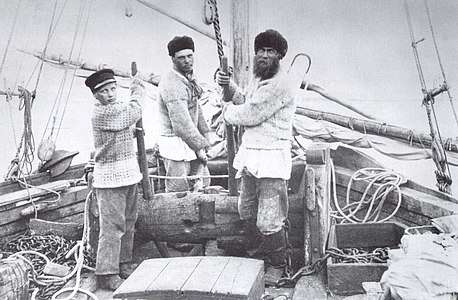 Russia's Arctic coastline from the White Sea to the Bering Strait had been explored and settled by Pomors, Russian settlers from Novgorod
Russia's Arctic coastline from the White Sea to the Bering Strait had been explored and settled by Pomors, Russian settlers from Novgorod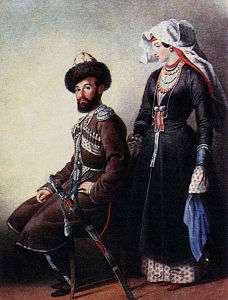 Terek Cossacks of the north Caucasus guarded the southern frontier
Terek Cossacks of the north Caucasus guarded the southern frontier
Population
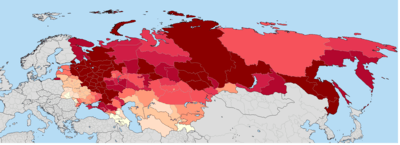
In 2010, the world's Russian population was 129 million people of which 86% were in Russia, 11.5% in the CIS and Baltic countries, with a further 2.5% living in other countries.[61]
Russia
Roughly 111 million ethnic Russians live in Russia, 80% of whom live in the European part of Russia, and 20% in the Asian part of the country.
.jpg)
Former Soviet states
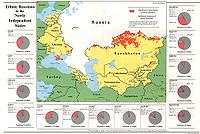
After the Dissolution of the Soviet Union an estimated 25 million Russians began living outside of the Russian Federation, most of them in the former Soviet Republics.
Diaspora
Ethnic Russians historically migrated throughout the area of former Russian Empire and Soviet Union, sometimes encouraged to re-settle in borderlands by the Tsarist and later Soviet government.[62] On some occasions, ethnic Russian communities, such as Lipovans who settled in the Danube delta or Doukhobors in Canada, emigrated as religious dissidents fleeing the central authority.
After the Russian Revolution and Russian Civil War starting in 1917, many Russians were forced to leave their homeland fleeing the Bolshevik regime, and millions became refugees. Many white émigrés were participants in the White movement, although the term is broadly applied to anyone who may have left the country due to the change in regime.
Today the largest ethnic Russian diasporas outside Russia live in former Soviet states such as Ukraine (about 8 million), Kazakhstan (about 3.8 million), Belarus (about 785,000), Latvia (about 520,000) with the most Russian settlement out of the Baltic States which includes Lithuania and Estonia, Uzbekistan (about 650,000) and Kyrgyzstan (about 419,000).
There are also small Russian communities in the Balkans, including Lipovans in the Danube delta,[63] Central European nations such as Germany and Poland, as well Russians settled in China, Japan, South Korea, Mexico, Brazil, Argentina and Australia. These communities may identify themselves either as Russians or citizens of these countries, or both, to varying degrees.

People who had arrived in Latvia and Estonia during the Soviet era, including their descendants born in these countries, mostly Russians, became stateless after the dissolution of the Soviet Union and were provided only with an option to acquire naturalised citizenship. The language issue is still contentious, particularly in Latvia, where ethnic Russians have protested against plans to liquidate education in minority languages, including Russian. Since 1992, Estonia has naturalized some 137,000 residents of undefined citizenship, mainly ethnic Russians. 136,000, or 10 percent of the total population, remain without citizenship. Both the European Union and the Council of Europe, as well as the Russian government, expressed their concern during the 1990s about minority rights in several countries, most notably Latvia and Estonia. In Moldova, the Transnistria region (where 30.4% of the population is Russian) broke away from government control amid fears the country would soon reunite with Romania. In June 2006, Russian President Vladimir Putin announced the plan to introduce a national policy aiming at encouraging ethnic Russians to immigrate to Russia.[64]
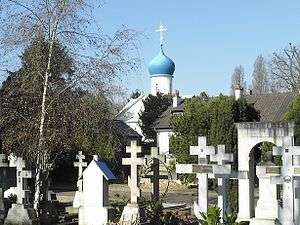
Significant numbers of Russians emigrated to Canada, Australia and the United States. Brighton Beach, Brooklyn and South Beach, Staten Island in New York City is an example of a large community of recent Russian and Russian Jewish immigrants. Other examples are Sunny Isles Beach, a northern suburb of Miami, and in West Hollywood of the Los Angeles area.
At the same time, many ethnic Russians from former Soviet territories have emigrated to Russia itself since the 1990s. Many of them became refugees from a number of states of Central Asia and Caucasus (as well as from the separatist Chechen Republic), forced to flee during political unrest and hostilities towards Russians.
After the Russian Revolution in 1917, many Russians who were identified with the White army moved to China — most of them settling in Harbin and Shanghai.[65] By the 1930s, Harbin had 100,000 Russians. Many of these Russians had to move back to the Soviet Union after World War II. Today, a large group of people in northern China can still speak Russian as a second language.
Russians (eluosizu) are one of the 56 ethnic groups officially recognized by the People's Republic of China (as the Russ); there are approximately 15,600 Russian Chinese living mostly in northern Xinjiang, and also in Inner Mongolia and Heilongjiang.
Language
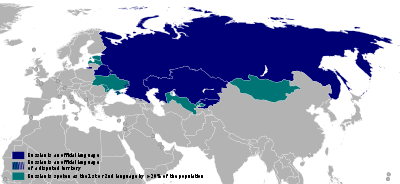
Russian (русский язык , transliteration: Russkiy yazyk, [ˈruskʲɪj jɪˈzɨk]) is the most geographically widespread language of Eurasia and the most widely spoken of the Slavic languages. Russian belongs to the family of Indo-European languages and is one of three (or, according to some authorities, four) living members of the East Slavic languages, the others being Belarusian, Ukrainian and Rusyn.
Examples of Old East Slavonic are attested from the 10th century onwards, and while Russian preserves much of East Slavonic grammar and a Common Slavonic word base, modern Russian exhibits a large stock of borrowed international vocabulary for politics, science, and technology.
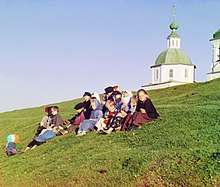
Russian has palatal secondary articulation of consonants, the so-called soft and hard sounds. This distinction is found in most consonant phonemes and is one of the most distinguishing features of the language. Another important aspect is the reduction of unstressed vowels, not unlike a similar process in English. Stress in Russian is often described as "unpredictable": it can fall on almost any syllable, and this is one of the difficult aspects for foreign language learners.
Due to the status of the Soviet Union as a super power, Russian gained a great political importance in the second half of the 20th century. It is one of the official languages of the United Nations. All astronauts working in the International Space Station are required to master Russian.
According to data published in the journal «Language Monthly» (No. 3, 1997), approximately 300 million people around the world at the time mastered the Russian language (making it the 5th most popular language in the world by total number of speakers), while 160 million considered Russian their native language (making it the 7th in the world by number of native speakers). The total number of Russian speakers in the world in the 1999 assessment was about 167 million, with about 110 million people speaking Russian as a second language.
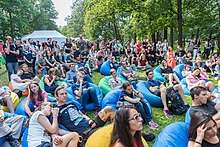
Prior to 1991, Russian was the language of international communication of the USSR and the most common foreign language taught in schools in the countries of the Eastern Bloc in Central Europe. It continues to be used in the countries that were formerly parts of the Soviet Union, both as the mother tongue of a significant percentage of the population, and as a language of international communication. While for various reasons residents of these countries might be unwilling to openly identify with Russian language, a major sociological study on the Russian language in the post-Soviet states conducted by Gallup, Inc., revealed that 92% of the survey respondents in Belarus, 83% in Ukraine, 68% in Kazakhstan and 38% in Kyrgyzstan chose Russian-language forms to complete the questionnaire for the survey (most notably, over forms in corresponding national languages).
In the U.S. state of New York in 2009, an amendment to the electoral law was adopted, according to which in all cities in the state having over a million people, all documents related to the election process should be translated into Russian (thus gaining equal status with Spanish, Korean, Filipino, Creole languages and three varieties of Chinese).
In places of compact residence of immigrants from the countries of the former USSR (Israel, Germany, Canada, the United States, Australia, etc.) Russian-language periodicals, radio and television channels are available, as well as Russian-language schools.
Culture
Literature
Russian literature is considered to be among the most influential and developed in the world, with some of the most famous literary works belonging to it.[66] Russia's literary history dates back to the 10th century; in the 18th century its development was boosted by the works of Mikhail Lomonosov and Denis Fonvizin, and by the early 19th century a modern native tradition had emerged, producing some of the greatest writers of all time. This period and the Golden Age of Russian Poetry began with Alexander Pushkin, considered to be the founder of modern Russian literature and often described as the "Russian Shakespeare" or the "Russian Goethe".[67] It continued in the 19th century with the poetry of Mikhail Lermontov and Nikolay Nekrasov, dramas of Aleksandr Ostrovsky and Anton Chekhov, and the prose of Nikolai Gogol, Ivan Turgenev, Leo Tolstoy, Fyodor Dostoyevsky, Mikhail Saltykov-Shchedrin, Ivan Goncharov, Aleksey Pisemsky and Nikolai Leskov. Tolstoy and Dostoevsky in particular were titanic figures, to the point that many literary critics have described one or the other as the greatest novelist ever.[68][69]
By the 1880s Russian literature had begun to change. The age of the great novelists was over and short fiction and poetry became the dominant genres of Russian literature for the next several decades, which later became known as the Silver Age of Russian Poetry. Previously dominated by realism, Russian literature came under strong influence of symbolism in the years between 1893 and 1914. Leading writers of this age include Valery Bryusov, Andrei Bely, Vyacheslav Ivanov, Aleksandr Blok, Nikolay Gumilev, Dmitry Merezhkovsky, Fyodor Sologub, Anna Akhmatova, Osip Mandelstam, Marina Tsvetaeva, Leonid Andreyev, Ivan Bunin, and Maxim Gorky.
Following the Russian Revolution of 1917 and the ensuing civil war, Russian cultural life was left in chaos. Some prominent writers, like Ivan Bunin and Vladimir Nabokov left the country, while a new generation of talented writers joined together in different organizations with the aim of creating a new and distinctive working-class culture appropriate for the new state, the Soviet Union. Throughout the 1920s writers enjoyed broad tolerance. In the 1930s censorship over literature was tightened in line with Joseph Stalin's policy of socialist realism. After his death the restrictions on literature were eased, and by the 1970s and 1980s, writers were increasingly ignoring official guidelines. The leading authors of the Soviet era included Yevgeny Zamiatin, Isaac Babel, Vladimir Mayakovsky, Ilf and Petrov, Yury Olesha, Mikhail Bulgakov, Boris Pasternak, Mikhail Sholokhov, Aleksandr Solzhenitsyn, Yevgeny Yevtushenko, and Andrey Voznesensky.
The Soviet era was also the golden age of Russian science fiction, that was initially inspired by western authors and enthusiastically developed with the success of Soviet space program. Authors like Arkady and Boris Strugatsky, Kir Bulychev, Ivan Yefremov, Alexander Belyaev enjoyed mainstream popularity at the time. An important theme of Russian literature has always been the Russian soul.
| Pushkin (1799–1837) |
Gogol (1809–1852) |
Turgenev (1818–1883) |
Dostoevsky (1821–1881) |
Tolstoy (1828–1910) |
Chekhov (1860–1904) |
Bulgakov (1891–1940) |
|---|---|---|---|---|---|---|
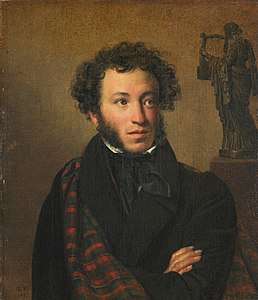 | .jpg) |  | _-_Portrait_of_Leo_Tolstoy_(1887).jpg) | 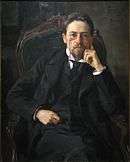 |  |
Philosophy
Some Russian writers, like Tolstoy and Dostoyevsky, are known also as philosophers, while many more authors are known primarily for their philosophical works. Russian philosophy blossomed since the 19th century, when it was defined initially by the opposition of Westernizers, advocating Russia's following the Western political and economical models, and Slavophiles, insisting on developing Russia as a unique civilization. The latter group includes Nikolai Danilevsky and Konstantin Leontiev, the early founders of Eurasianism.
In its further developments, Russian philosophy was always marked by a deep connection to literature and interest in creativity, society, politics and nationalism; cosmos and religion were other primary subjects. Notable philosophers of the late 19th and early 20th centuries include Vladimir Solovyov, Sergei Bulgakov, Pavel Florensky, Nikolai Berdyaev, Vladimir Lossky and Vladimir Vernadsky. In the 20th century Russian philosophy became dominated by Marxism.
| Bakunin (1814–1876) |
Kropotkin (1842–1921) |
Solovyov (1853–1900) |
Shestov (1866–1938) |
Berdyaev (1874–1948) |
|---|---|---|---|---|
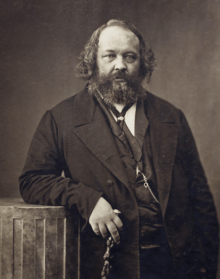 |  |  | 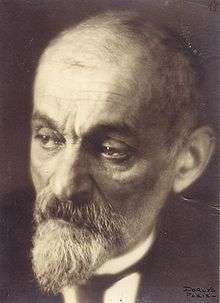 |  |
Science
At the start of the 18th century the reforms of Peter the Great (the founder of Russian Academy of Sciences and Saint Petersburg State University) and the work of such champions as polymath Mikhail Lomonosov (the founder of Moscow State University) gave a great boost for development of science, engineering and innovation in Russia. In the 19th and 20th centuries Russia produced a large number of great scientists and inventors.
Nikolai Lobachevsky, a Copernicus of Geometry, developed the non-Euclidean geometry. Dmitry Mendeleev invented the Periodic table, the main framework of the modern chemistry. Nikolay Benardos introduced the arc welding, further developed by Nikolay Slavyanov, Konstantin Khrenov and other Russian engineers. Gleb Kotelnikov invented the knapsack parachute, while Evgeniy Chertovsky introduced the pressure suit. Pavel Yablochkov and Alexander Lodygin were great pioneers of electrical engineering and inventors of early electric lamps.
Alexander Popov was among the inventors of radio, while Nikolai Basov and Alexander Prokhorov were co-inventors of lasers and masers. Igor Tamm, Andrei Sakharov and Lev Artsimovich developed the idea of tokamak for controlled nuclear fusion and created its first prototype, which finally led to the modern ITER project. Many famous Russian scientists and inventors were émigrés, like Igor Sikorsky and Vladimir Zworykin, and many foreign ones worked in Russia for a long time, like Leonard Euler and Alfred Nobel.
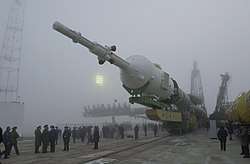
The greatest Russian successes are in the field of space technology and space exploration. Konstantin Tsiolkovsky was the father of theoretical astronautics.[70] His works had inspired leading Soviet rocket engineers such as Sergei Korolev, Valentin Glushko, and many others that contributed to the success of the Soviet space program at early stages of the Space Race and beyond.
In 1957 the first Earth-orbiting artificial satellite, Sputnik 1, was launched; in 1961 on 12 April the first human trip into space was successfully made by Yury Gagarin; and many other Soviet and Russian space exploration records ensued, including the first spacewalk performed by Alexei Leonov, the first space exploration rover Lunokhod-1 and the first space station Salyut 1. Nowadays Russia is the largest satellite launcher[71][72] and the only provider of transport for space tourism services.
Other technologies, where Russia historically leads, include nuclear technology, aircraft production and arms industry. The creation of the first nuclear power plant along with the first nuclear reactors for submarines and surface ships was directed by Igor Kurchatov. NS Lenin was the world's first nuclear-powered surface ship as well as the first nuclear-powered civilian vessel, and NS Arktika became the first surface ship to reach the North Pole.
A number of prominent Soviet aerospace engineers, inspired by the theoretical works of Nikolai Zhukovsky, supervised the creation of many dozens of models of military and civilian aircraft and founded a number of KBs (Construction Bureaus) that now constitute the bulk of Russian United Aircraft Corporation. Famous Russian airplanes include the first supersonic passenger jet Tupolev Tu-144 by Alexei Tupolev, MiG fighter aircraft series by Artem Mikoyan and Mikhail Gurevich, and Su series by Pavel Sukhoi and his followers. MiG-15 is the world's most produced jet aircraft in history, while MiG-21 is most produced supersonic aircraft. During World War II era Bereznyak-Isayev BI-1 was introduced as the first rocket-powered fighter aircraft, and Ilyushin Il-2 bomber became the most produced military aircraft in history. Polikarpov Po-2 Kukuruznik is the world's most produced biplane, and Mil Mi-8 is the most produced helicopter.
Famous Russian battle tanks include T-34, the best tank design of World War II,[73] and further tanks of T-series, including T-54/55, the most produced tank in history,[74] first fully gas turbine tank T-80 and the most modern Russian tank T-90. The AK-47 and AK-74 by Mikhail Kalashnikov constitute the most widely used type of assault rifle throughout the world – so much so that more AK-type rifles have been produced than all other assault rifles combined.[75][76] With these and other weapons Russia for a long time has been among the world's top suppliers of arms.
Music
Music in 19th-century Russia was defined by the tension between classical composer Mikhail Glinka along with the other members of The Mighty Handful, who embraced Russian national identity and added religious and folk elements to their compositions, and the Russian Musical Society led by composers Anton and Nikolay Rubinstein, which was musically conservative. The later Romantic tradition of Pyotr Ilyich Tchaikovsky, one of the most popular composers of the Romantic era, whose music has come to be known and loved for its distinctly Russian character as well as its rich harmonies and stirring melodies, was brought into the 20th century by Sergei Rachmaninoff, one of the last great champions of the Romantic style of European classical music.[77]
World-renowned composers of the 20th century included Alexander Scriabin, Igor Stravinsky, Sergei Rachmaninoff, Sergei Prokofiev, Dmitri Shostakovich and Georgy Sviridov. During most of the Soviet Era, music was highly scrutinized and kept within a conservative, accessible idiom in conformity with the policy of socialist realism.
Soviet and Russian conservatories have turned out generations of world-renowned soloists. Among the best known are violinists David Oistrakh and Gidon Kremer; cellist Mstislav Rostropovich; pianists Vladimir Horowitz, Sviatoslav Richter, and Emil Gilels; and vocalists Fyodor Shalyapin, Galina Vishnevskaya, Anna Netrebko and Dmitry Hvorostovsky.[78]
| Glinka (1804–1857) |
Mussorgsky (1839–1881) |
Tchaikovsky (1840–1893) |
Rimsky-Korsakov (1844–1908) |
Rachmaninoff (1873–1943) |
Stravinsky (1882–1971) |
Shostakovich (1906–1975) |
|---|---|---|---|---|---|---|
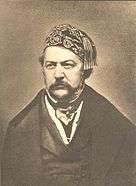 |  | .jpg) | 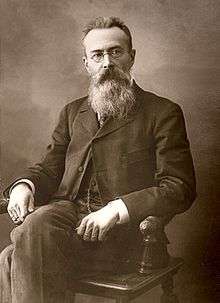 | 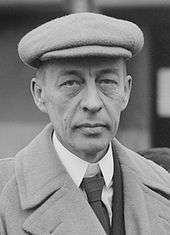 | 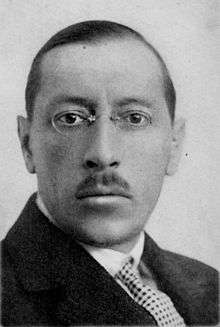 | 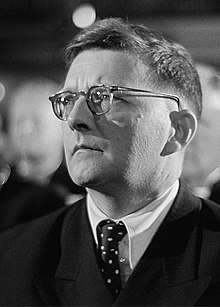 |
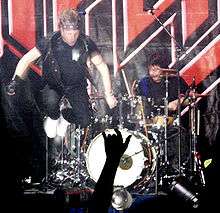
Since the late Soviet times Russia has experienced another wave of Western cultural influence, which led to the development of many previously unknown phenomena in the Russian culture. The most vivid example, perhaps, is the Russian rock music, which takes its roots both in the Western rock and roll and heavy metal, and in traditions of the Russian bards of Soviet era, like Vladimir Vysotsky and Bulat Okudzhava. Saint-Petersburg (former Leningrad), Yekaterinburg (former Sverdlovsk) and Omsk became the main centers of development of the rock music. Popular Russian rock groups include Mashina Vremeni, Slot, DDT, Aquarium, Alisa, Kino, Nautilus Pompilius, Aria, Grazhdanskaya Oborona, Splean and Korol i Shut. At the same time Russian pop music developed from what was known in the Soviet times as estrada into full-fledged industry, with some performers gaining international recognition, like t.A.T.u. in the West, who have been said to be the most influential artists to ever come out of Russia, or Vitas in China. Another kind of music, Hardbass, has become an internet meme
Cinema
While in the industrialized nations of the West, motion pictures had first been accepted as a form of cheap recreation and leisure for the working class, Russian filmmaking came to prominence following the 1917 revolution when it explored editing as the primary mode of cinematic expression.[79] Russian and later Soviet cinema was a hotbed of invention in the period immediately following the 1917 revolution, resulting in world-renowned films such as Battleship Potemkin.[80] Soviet-era filmmakers, most notably Sergei Eisenstein and Andrei Tarkovsky, would become some of the world's most innovative and influential directors.
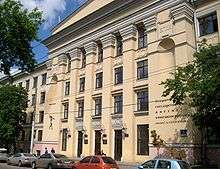
Eisenstein was a student of filmmaker and theorist Lev Kuleshov, who developed the groundbreaking Soviet montage theory of film editing at the world's first film school, the All-Union Institute of Cinematography. Dziga Vertov, whose kino-glaz ("film-eye") theory—that the camera, like the human eye, is best used to explore real life—had a huge impact on the development of documentary film making and cinema realism. In 1932, Stalin made socialist realism the state policy; this somewhat limited creativity, however many Soviet films in this style were artistically successful, like Chapaev, The Cranes Are Flying, and Ballad of a Soldier.[80]
1960s and 1970s saw a greater variety of artistic styles in the Soviet cinema. Eldar Ryazanov's and Leonid Gaidai's comedies of that time were immensely popular, with many of the catch phrases still in use today. In 1961–1967 Sergey Bondarchuk directed an Oscar-winning film adaptation of Tolstoy's epic War and Peace, which was the most expensive Soviet film made.[81] In 1969, Vladimir Motyl's White Sun of the Desert was released, a very popular film in a genre known as 'osterns'; the film is traditionally watched by cosmonauts before any trip into space.[82]
The late 1980s and 1990s were a period of crisis in Russian cinema and animation. Although Russian filmmakers became free to express themselves, state subsidies were drastically reduced, resulting in fewer films produced. The early years of the 21st century have brought increased viewership and subsequent prosperity to the industry on the back of the economy's rapid development, and production levels are already higher than in Britain and Germany.[83] Russia's total box-office revenue in 2007 was $565 million, up 37% from the previous year[84] (by comparison, in 1996 revenues stood at $6 million).[83] Russian cinema continues to receive international recognition. Russian Ark (2002) was the first feature film ever to be shot in a single take.
Architecture
Russian architecture began with the woodcraft buildings of ancient Slavs. Some characteristics taken from the Slavic pagan temples are the exterior galleries and the plurality of towers. Since the Christianization of Kievan Rus', for several centuries Russian architecture was influenced predominantly by the Byzantine architecture, until the Fall of Constantinople. Apart from fortifications (kremlins), the main stone buildings of ancient Rus' were Orthodox churches, with their many domes, often gilded or brightly painted. Aristotle Fioravanti and other Italian architects brought Renaissance trends into Russia. The 16th century saw the development of unique tent-like churches culminating in Saint Basil's Cathedral. By that time the onion dome design was also fully developed. In the 17th century, the "fiery style" of ornamentation flourished in Moscow and Yaroslavl, gradually paving the way for the Naryshkin baroque of the 1690s. After Peter the Great reforms had made Russia much closer to Western culture, the change of the architectural styles in the country generally followed that of Western Europe.
The 18th-century taste for Rococo architecture led to the splendid works of Bartolomeo Rastrelli and his followers. During the reign of Catherine the Great and her grandson Alexander I, the city of Saint Petersburg was transformed into an outdoor museum of Neoclassical architecture. The second half of the 19th century was dominated by the Byzantine and Russian Revival style (this corresponds to Gothic Revival in Western Europe). Prevalent styles of the 20th century were the Art Nouveau (Fyodor Shekhtel), Constructivism (Moisei Ginzburg and Victor Vesnin), and the Stalin Empire style (Boris Iofan). After Stalin's death a new Soviet leader, Nikita Khrushchev, condemned the "excesses" of the former architectural styles, and in the late Soviet era the architecture of the country was dominated by plain functionalism. This helped somewhat to resolve the housing problem, but created the large massives of buildings of low architectural quality, much in contrast with the previous bright architecture. After the end of the Soviet Union the situation improved. Many churches demolished in the Soviet times were rebuilt, and this process continues along with the restoration of various historical buildings destroyed in World War II. As for the original architecture, there is no more any common style in modern Russia, though International style has a great influence.
Some notable Russian buildings include:
- Saint Sophia Cathedral in Novgorod | Golden Gate (Vladimir) | Cathedral of Christ the Saviour | Assumption Cathedral in Vladimir | Cathedral of the Annunciation | Cathedral of the Archangel | Cathedral of the Dormition | Church of the Savior on Blood | Saint Basil's Cathedral | Kazan Kremlin | Saint Isaac's Cathedral | Kazan Cathedral | Peter and Paul Cathedral | Sukharev Tower | Menshikov Tower | Moscow Manege | Narva Triumphal Gate | Kolomenskoye | Peterhof Palace | Gatchina | Troitse-Sergiyeva Lavra | Solovetsky Monastery | Kunstkamera | Russian Museum | Catherine Palace | Grand Kremlin Palace | Winter Palace | Simonov Monastery | Novodevichy Convent | Lenin's Mausoleum | Tatlin's Tower | Palace of the Soviets | Seven Sisters (Moscow) | All-Soviet Exhibition Centre | Ostankino Tower | Triumph-Palace | White House of Russia
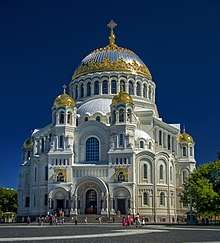
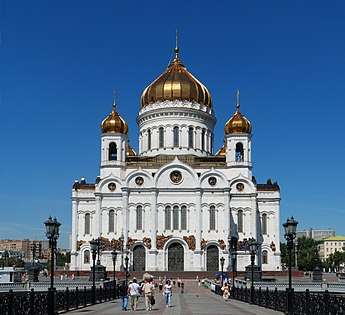 Cathedral of Christ the Saviour in Moscow
Cathedral of Christ the Saviour in Moscow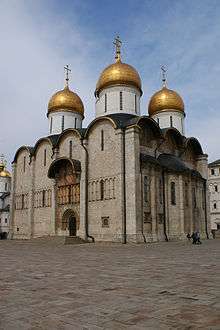
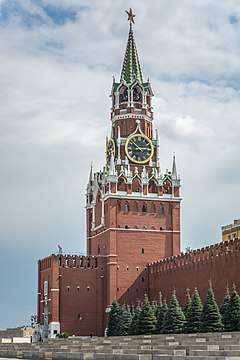 Spasskaya Tower from the Moscow Kremlin
Spasskaya Tower from the Moscow Kremlin Saint Basil's Cathedral in Moscow
Saint Basil's Cathedral in Moscow Saint Isaac's Cathedral from Saint Petersburg
Saint Isaac's Cathedral from Saint Petersburg
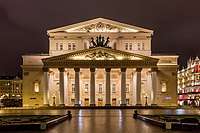 The Bolshoi Theatre in Moscow
The Bolshoi Theatre in Moscow- Church of the Savior on Blood in Saint Petersburg
 The Winter Palace from Saint Petersburg
The Winter Palace from Saint Petersburg.jpg) GUM in Moscow
GUM in Moscow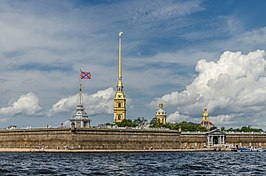 Peter and Paul Fortress in Saint Petersburg
Peter and Paul Fortress in Saint Petersburg.jpg) Kazan Cathedral in Saint Petersburg
Kazan Cathedral in Saint Petersburg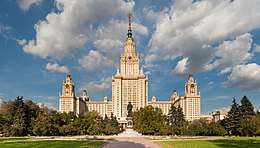 The main building of Moscow State University in Moscow
The main building of Moscow State University in Moscow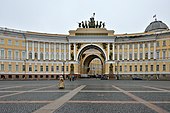 General Staff Building in Saint Petersburg
General Staff Building in Saint Petersburg Kunstkamera in Saint Petersburg
Kunstkamera in Saint Petersburg
Religion
.jpg)
As of a different sociological surveys on religious adherence, from 41% to over 80% of the total population of Russia adhere to the Russian Orthodox Church.[85][86][87][88][89] It has played a vital role in the development of Russian national identity. In other countries Russian faithful usually belong to the local Orthodox congregations which either have a direct connection (like the Ukrainian Orthodox Church, autonomous from the Moscow Patriarchate) or historical origin (like the Orthodox Church in America or a Russian Orthodox Church Outside of Russia) with the Russian Orthodox Church.
Non-religious Russians may associate themselves with the Orthodox faith for cultural reasons. Some Russian people are Old Believers: a relatively small schismatic group of the Russian Orthodoxy that rejected the liturgical reforms introduced in the 17th century. Other schisms from Orthodoxy include Doukhobors which in the 18th century rejected secular government, the Russian Orthodox priests, icons, all church ritual, the Bible as the supreme source of divine revelation and the divinity of Jesus, and later emigrated into Canada. An even earlier sect were Molokans which formed in 1550 and rejected Czar's divine right to rule, icons, the Trinity as outlined by the Nicene Creed, Orthodox fasts, military service, and practices including water baptism.
Other world religions have negligible representation among ethnic Russians. The largest of these groups are Islam with over 100,000 followers from national minorities,[85] and Baptists with over 85,000 Russian adherents.[90] Others are mostly Pentecostals, Evangelicals, Seventh-day Adventists, Lutherans and Jehovah's Witnesses.
Since the fall of the Soviet Union various new religious movements have sprung up and gathered a following among ethnic Russians. The most prominent of these are Rodnovery, the revival of the Slavic native religion also common to other Slavic nations,[91] Another movement, very small in comparison to other new religions, is Vissarionism, a syncretic group with an Orthodox Christian background.
Sports
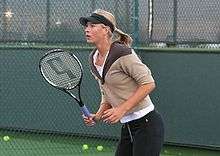
Russians have been successful at a number of sports and consistently finish in the top rankings at the Olympic Games and in other international competitions. Combining the total medals of Soviet Union and Russia, the country is second among all nations by number of gold medals both at the Summer Olympics and at the Winter Olympics.
During the Soviet era, the national Olympic team placed first in the total number of medals won at 14 of its 18 appearances; with these performances, the USSR was the dominant Olympic power of its era. Since the 1952 Olympic Games, Soviet and later Russian athletes have always been in the top three for the number of gold medals collected at the Summer Olympics.
Soviet gymnasts, track-and-field athletes, weight lifters, wrestlers, boxers, fencers, shooters, chess players, cross country skiers, biathletes, speed skaters and figure skaters were consistently among the best in the world, along with Soviet basketball, handball, volleyball and ice hockey players. Since the collapse of the Soviet Union, Russian athletes have continued to dominate international competitions. The 1980 Summer Olympic Games were held in Moscow while the 2014 Winter Olympics and the 2014 Winter Paralympics were hosted by Sochi.
Soviet Union dominated the sport of gymnastics for many years, with such athletes as Larisa Latynina, who, until 2012, held a record of most Olympic medals won per person and most gold Olympic medals won by a woman. Today, Russia is leading in rhythmic gymnastics with such stars as Alina Kabaeva, Irina Tschaschina and Yevgeniya Kanayeva.
Russian synchronized swimming is the best in the world, with almost all gold medals having been swept by Russians at Olympics and World Championships for more than a decade. Figure skating is another popular sport in Russia; in the 1960s, the Soviet Union rose to become a dominant power in figure skating, especially in pair skating and ice dancing, and at every Winter Olympics from 1964 until 2006, a Soviet or Russian pair has won gold, often considered the longest winning streak in modern sports history. Since the end of the Soviet era, tennis has grown in popularity and Russia has produced a number of famous tennis players. Chess is also a widely popular pastime; from 1927, Soviet and Russian chess grandmasters have held the world championship almost continuously.
Notable achievements
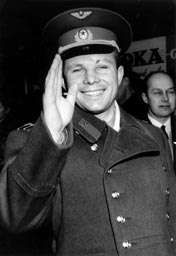
Russians have greatly contributed to the fields of sports, science and technology, politics, business, and the arts.
In science and technology, notable Russian scientists include Dmitri Mendeleev, Nikolay Bogolyubov, Konstantin Tsiolkovsky (a founding father of rocketry and astronautics), Andrei Kolmogorov, Ivan Pavlov, Nikolai Semyonov, Dmitri Ivanenko, Alexander Lodygin, Alexander Popov (one of inventors of radio), Nikolai Zhukovsky, Alexander Prokhorov and Nikolay Basov (co-inventors of laser), Vladimir Zworykin, Lev Pontryagin, Sergei Sobolev, Pavel Yablochkov, Aleksandr Butlerov, Andrei Sakharov, Dmitry Ivanovsky, Sergey Korolyov and Mstislav Keldysh (creators of the Soviet space program), Aleksandr Lyapunov, Mikhail Dolivo-Dobrovolsky, Andrei Tupolev, Yuri Denisyuk (the first practicable method of holography), Mikhail Lomonosov, Vladimir Vernadsky, Pyotr Kapitsa, Igor Sikorsky, Ludvig Faddeev, Konstantin Novoselov, Fyodor Shcherbatskoy, Mikhail Kalashnikov (inventor and designer of the AK-47 assault rifle and PK machine gun), and Nikolai Trubetzkoy.
The first man in space, Yuri Gagarin, was a Russian, and the first artificial satellite to be put into outer space, Sputnik 1, was launched by the Soviet Union and was developed mainly by Russian aerospace engineer Sergey Korolyov.

Russian Literature representatives like Leo Tolstoy, Fyodor Dostoevsky, Ivan Turgenev, Anton Chekhov, Alexander Pushkin, and many more, reached a high status in world literature. Prominent Russian novelists such as Tolstoy in particular, were important figures and have remained internationally renowned. Some scholars have described one or the other as the greatest novelist ever.[93]
Russian composers who reached a high status in the world of music include Igor Stravinsky, Pyotr Ilyich Tchaikovsky, Dmitri Shostakovich, Nikolai Rimsky-Korsakov, Sergei Prokofiev, Modest Mussorgsky, and Sergei Rachmaninoff.
Russian people played a crucial role in the victory over Nazi Germany in World War II. According to the British historian Richard Overy, the Eastern Front included more combat than all the other European fronts combined—the Wehrmacht suffered 80% to 93% of all of its total World War II combat casualties on the Eastern Front. Russia's casualties in this war were the highest of all nations, and numbered more than 20 million dead (Russians composed 80% of the 26.6 million people lost by the USSR), which is about half of all World War II casualties and the vast majority of Allied casualties.[94]
See also
- All-Russian nation
- European ethnic groups
- List of Russian artists
References
- "Russian". Joshua Project. Retrieved 10 August 2020.
- "Russian in Russia". Joshua Project. Retrieved 11 August 2020.
- http://www.ukrstat.gov.ua/
- "Численность населения Республики Казахстан по отдельным этносам на начало 2016 года". stat.gov.kz.
- https://www.destatis.de/DE/Publikationen/Thematisch/Bevoelkerung/MigrationIntegration/AuslaendBevoelkerung2010200177004.pdf
- "Regarding Upcoming Conference on Status of Russian Language Abroad". Russian Ministry of Foreign Affairs. Archived from the original on 23 December 2015. Retrieved 24 June 2014.
- "American FactFinder – Results". Data Access and Dissemination Systems (DADS). Archived from the original on 12 February 2020. Retrieved 19 September 2016.
- http://jppi.org.il/uploads/Jewish_Demographic_Policies.pdf
- http://www.belstat.gov.by/upload-belstat/upload-belstat-pdf/perepis_2009/5.8-0.pdf
- "Archived copy". Archived from the original on 14 November 2018. Retrieved 18 January 2019.CS1 maint: archived copy as title (link)
- "Census Profile, 2016 Census". statcan.gc.ca.
- http://data1.csb.gov.lv/pxweb/en/iedz/iedz__iedzrakst/IRG070.px/table/tableViewLayout1/?rxid=d8284c56-0641-451c-8b70-b6297b58f464
- "Moldovan Population Census from 2014". Moldovan National Bureau of Statistics.
- "Archived copy". Archived from the original on 27 December 2018. Retrieved 18 January 2019.CS1 maint: archived copy as title (link)
- Maria Stella Ferreira Levy. O papel da migração internacional na evolução da população brasileira (1872 to 1972). inRevista de Saúde Pública, volume supl, June 1974.
- "Archived copy". Archived from the original on 11 June 2019. Retrieved 1 February 2020.CS1 maint: archived copy as title (link)
- https://www.ellitoral.com/index.php/diarios/2018/02/25/informaciongeneral/INFO-02.html
- "Archived copy". Archived from the original on 19 January 2019. Retrieved 19 January 2019.CS1 maint: archived copy as title (link)
- "Gyventojų pagal tautybę dalis, palyginti su bendru nuolatinių gyventojų skaičiumi". osp.stat.gov.lt. Retrieved 13 August 2017.
- "2006 census".
- "The State Statistical Committee of the Republic of Azerbaijan". azstat.org. Archived from the original on 7 January 2012.
- "communauté russe en France" (PDF). Archived from the original (PDF) on 12 April 2019. Retrieved 19 January 2019.
- http://pxnet2.stat.fi/PXWeb/pxweb/fi/StatFin/StatFin__vrm__vaerak/statfin_vaerak_pxt_11rv.px/table/tableViewLayout1/?rxid=726cd24d-d0f1-416a-8eec-7ce9b82fd5a4
- "Australian Bureau of Statistics". Abs.gov.au. Retrieved 22 July 2012.
- "МИД России | 12/02/2009 | Интервью Посла России в Турции В.Е.Ивановского, опубликованное в журнале "Консул" № 4 /19/, декабрь 2009 года". Mid.ru. Archived from the original on 2 January 2016. Retrieved 22 July 2012.
- . Migrationpolicy https://www.migrationpolicy.org/programs/data-hub/charts/immigrant-and-emigrant-populations-country-origin-and-destination. Retrieved 7 August 2020. Missing or empty
|title=(help) - Informatii utile | Agentia Nationala pentru Intreprinderi Mici si Mijlocii (2002 census) (in Romanian)
- "(number of foreigners in the Czech Republic)" (PDF) (in Czech). 31 December 2016. Retrieved 6 October 2017.
- http://www.demoscope.ru/weekly/2013/0559/barom02.php
- "출입국·외국인정책 통계월보". 출입국·외국인정책 본부 이민정보과.
- The source is not Russian but Russian Koreans.
- http://census.ge/files/results/english/17_Total%20population%20by%20regions%20and%20ethnicity.xls
- Vukovich, Gabriella (2018). Mikrocenzus 2016 – 12. Nemzetiségi adatok [2016 microcensus – 12. Ethnic data] (PDF). Hungarian Central Statistical Office (in Hungarian). Budapest. ISBN 978-963-235-542-9. Retrieved 9 January 2019.
- "Utrikes födda efter födelseland, kön och år". www.scb.se. Statistiska Centralbyrån. Retrieved 25 May 2017.
- "(2000 census)". Stats.gov.cn. Retrieved 22 July 2012.
- "(2002 census)". Nsi.bg. Retrieved 22 July 2012.
- "(2002 census)" (PDF). Retrieved 22 July 2012.
- "rcnk.gr". April 2020.
- "Statistics Denmark 2019 K4: Russian". Statistics Denmark.
- "Census ethnic group profiles: Russian". Stats NZ. 2013.
- {{citeweb|url=http://www.cystat.gov.cy/ www.cystat.gov.cy| year=2004 |title=POPULATION CENSUS 2001 VOL4
- "Two sources of the Russian patrilineal heritage in their Eurasian context". American Journal of Human Genetics. 82 (1): 236–50. January 2008. doi:10.1016/j.ajhg.2007.09.019. PMC 2253976. PMID 18179905.
- some territories of the former Tsardom of Russia and Russian Empire; those territories where people self-identified as ethnic (Great) Russians lived many hundreds of years in the end of 19 century/the beginning of 20 century; population and state borders are changed many times peacefully of not peacefully because of many reasons in 20–21 centuries, but demographic processes are slow and not related to recent changes of state borders
- "Russian". Ethnologue. Retrieved 10 August 2020.
- "Russian". Joshua Project. Retrieved 10 August 2020.
- Pravoslavie.ru. Retrieved 10 February 2016.
- Blöndal, Sigfús (16 April 2007). The Varangians of Byzantium. Cambridge University Press. p. 1. ISBN 9780521035521. Retrieved 2 February 2014.
- The Ru|||ssian Primary Chronicle: Laurentian Text, Translated by O. P. Sherbowitz-Wetzor ISBN 0-910956-34-0
- "Online Etymology Dictionary". etymonline.com.
- "Топонимические следы руссов-славян в Рослагене : Доисторическая история славян : Александр Козинский". kozinsky.ru. Archived from the original on 14 August 2019. Retrieved 14 August 2019.
- "Руслаген". поисковая система. Archived from the original on 14 August 2019. Retrieved 14 August 2019.
- Максимович К.А. (2006). "Происхождение этнонима Русь в свете исторической лингвистики и древнейших письменных источников". КАNIEKION. Юбилейный сборник в честь 60-летия профессора Игоря Сергеевича Чичурова. М.: ПЕТГУ: сс.14–56.
- Седов В.В. Древнерусская народность. Русы
- "Новости NEWSru.com :: Учёные завершили масштабное исследование генофонда русского народа (Фотороботы)". Newsru.com. Retrieved 22 July 2012.
- Aleksey Uvarov, "Étude sur les peuples primitifs de la Russie. Les mériens" (1875)
- Мурома, мещера [Murom, Meschera]. emc.komi.com (in Russian). Archived from the original on 23 May 2008.
- "Russia – History". Encyclopedia Britannica. Retrieved 28 August 2018.
- Kunstmann, Heinrich. (1996). Die Slaven : ihr Name, ihre Wanderung nach Europa und die Anfänge der russischen Geschichte in historisch-onomastischer Sicht. Steiner. p. 214. ISBN 3515068163. OCLC 231684405.
- The Primary Chronicle is a history of the Ancient Rus' from around 850 to 1110, originally compiled in Kiev about 1113.
- Pivtorak. Formation and dialectal differenciaton of the Old Rus language. 1988
- "журнал "Демоскоп Weekly" № 571 – 572 14 – 31 октября 2013. А. Арефьев. Тема номера: сжимающееся русскоязычие. Демографические изменения – не на пользу русскому языку".
- Russians left behind in Central Asia. BBC News. November 23, 2005.
- "Saving the souls of Russia's exiled Lipovans". The Daily Telegraph. April 9, 2013.
- Bigg, Claire (15 August 2006). "Latvia: Ethnic Russians Divided On Moscow's Repatriation Scheme". Rferl.org. Retrieved 22 July 2012.
- "The Ghosts of Russia That Haunt Shanghai". The New York Times. 21 September 1999.
- Microsoft Encarta Online Encyclopedia 2007. Russian Literature. Archived from the original on 20 August 2009. Retrieved 7 January 2008.
- Kelly, C (2001). Russian Literature: A Very Short Introduction (Very Short Introductions) (Paperback). Oxford Paperbacks. ISBN 0-19-280144-9.
- "Russian literature; Leo Tolstoy". Encyclopædia Britannica. Retrieved 11 April 2008.
- Otto Friedrich (6 September 1971). "Freaking-Out with Fyodor". Time Magazine. Retrieved 10 April 2008.
- "American Institute of Aeronautics and Astronautics – Home Page". Aiaa.org. Archived from the original on 4 January 2012. Retrieved 2 January 2010.
- Russian space program in 2009: plans and reality
- "Premium content". The Economist. 19 August 2009. Retrieved 2 January 2010.
- George Parada (n.d.), "Panzerkampfwagen T-34(r)" at Achtung Panzer! website, retrieved on 17 November 2008.
- Halberstadt, Hans Inside the Great Tanks The Crowood Press Ltd. Wiltshire, England 1997 94–96 ISBN 1-86126-270-1
"The T-54/T-55 series is the hands down, all-time most popular tank in history." - Poyer, Joe. The AK-47 and AK-74 Kalashnikov Rifles and Their Variations. North Cape Publications. 2004.
- "Weaponomics: The Economics of Small Arms" (PDF).
- Norris, Gregory; ed. Stanley, Sadie (1980). The New Grove Dictionary of Music and Musicians, 2nd edition. London: Macmillan. p. 707. ISBN 0-333-23111-2.CS1 maint: multiple names: authors list (link)
- "Russia::Music". Encyclopædia Britannica. Retrieved 5 October 2009.
- "History of the motion picture: The Soviet Union". Encyclopædia Britannica. Retrieved 7 January 2008.
- "Russia::Motion pictures". Encyclopædia Britannica. 2007. Retrieved 27 December 2007.
- Birgit Beumers. A History of Russian Cinema. Berg Publishers (2009). ISBN 978-1-84520-215-6. p. 143.
- "White Sun of the Desert / Beloe solntse pustyni". Film Society of Lincoln Center. Archived from the original on 5 September 2008. Retrieved 18 January 2008.
- Dzieciolowski, Z. "Kinoeye: Russia's reviving film industry". Archived from the original on 21 December 2007. Retrieved 27 December 2007.
- "Russian Entertainment & Media Industry worth $27.9 bn by 2011". PricewaterhouseCoopers. Archived from the original on 26 September 2007. Retrieved 27 December 2007.
- "Арена". Archived from the original on 2 December 2013. Retrieved 21 July 2013.
- Olga Filina (Ogonek Magazine). Mapping Russia's Religious Landscape. Russia and India Report. Retrieved 24-09-2012.
- Верю — не верю. "Ogonek", № 34 (5243), 27/08/2012. Retrieved 24-09-2012.
- "Archived copy" Опубликована подробная сравнительная статистика религиозности в России и Польше (in Russian). Archived from the original on 2 December 2015. Retrieved 6 January 2016.CS1 maint: archived copy as title (link)
- "Русская линия / Библиотека периодической печати / Как пишутся страшные сказки о Церкви". Rusk.ru. 31 August 2005. Retrieved 14 May 2011.
- "statistics". Adherents.com. Archived from the original on 10 August 2018. Retrieved 22 July 2012.
- Victor Shnirelman. "Christians! Go home": A Revival of Neo-Paganism between the Baltic Sea and Transcaucasia Archived 3 March 2016 at the Wayback Machine. Journal of Contemporary Religion, Vol. 17, No. 2, 2002.
- Tom Van Riper & Kurt Badenhausen (22 July 2008). "Top-Earning Female Athletes". Forbes. Retrieved 1 August 2008.
- "Russian literature." Encyclopædia Britannica. 2007. Encyclopædia Britannica Online. 16 July 2007 <>.
- Leaders mourn Soviet wartime dead, BBC News
External links

- Prominent Russians: faces of Russia – Russia Today
- (in Russian) 4.1. Population by nationality
- (in Russian) "People and Cultures: Russians" book published by Russian Academy of Sciences
- Pre-Revolutionary photos of women in Russian folk dress
